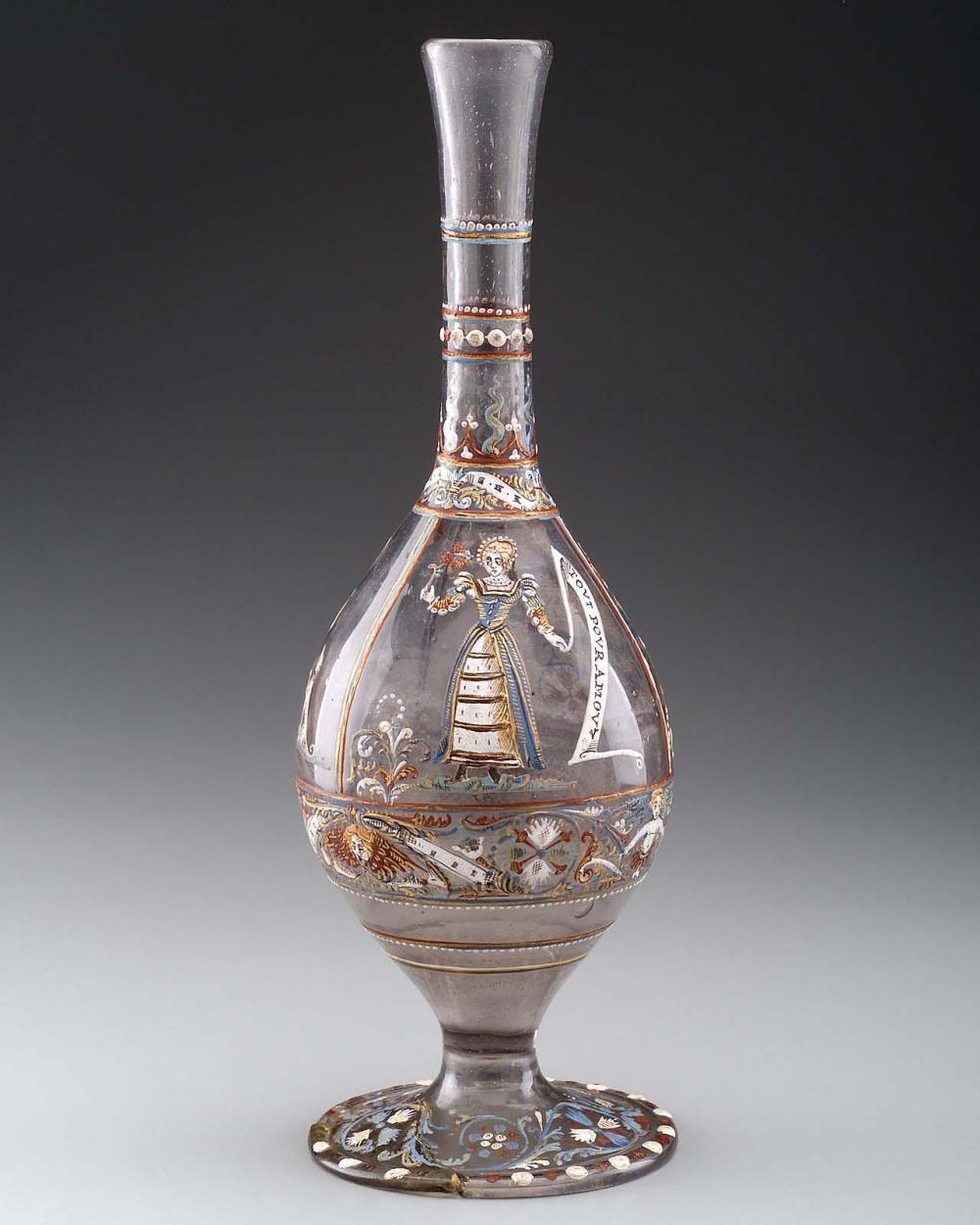Advanced Search 
Vase

Bottle
Vase
French
mid-16th century
Object Place: Europe, France
Medium/Technique
Glass, colorless, slightly gray, blown, with enameled and gilded decoration
Dimensions
Overall: 22.4 x 7.7 cm (8 13/16 x 3 1/16 in.)
Credit Line
Seth K. Sweetser Fund
Accession Number51.2473
CollectionsEurope
ClassificationsGlass
Venetian glass-making techniques spread to other parts of Europe. This clear bottle, made in France with painted colored enamel, is an object associated with love, courtship, and marriage. Its inscriptions read TOVT POVR AMOVR, “All for love,” and QVI BIEN AYME TARD OBBLIE, “Who loves well is slow to forget.”
DescriptionEnameled in blue, white, and red, and gilded. Enameled on the body, each in a separate compartment: a lady holding flowers, a white banderole above, with the inscription "TOVT POVR AMOVR"; a man holding a sword and torch (?), accompanied by a seated dog; and a white plaque, amid floral ornament, inscribed "QVI BIEN AYME / TARD OBBLIE." Foot enameled with ornament and beading.
InscriptionsInscribed in black enamel, on white banderoles: "TOVT POVR AMOVR [all for love]" and "QVI BIEN AYME TARD OBBLIE [who loves well forgets late, or remembers for a long time]".
ProvenanceBy 1866, Baron Anselm von Rothschild (b. 1803 - d. 1874), Vienna [see note 1]; by descent to his son, Baron Nathaniel von Rothschild (b. 1836 - d. 1905), Vienna [see note 2]; by descent to his nephew, Alphonse de Rothschild (b. 1878 - d. 1942) and Clarice de Rothschild (b. 1894 - d. 1967), Vienna; 1938, confiscated from Alphonse and Clarice de Rothschild by Nazi forces (no. AR 2473); taken to the Kunsthistorisches Museum, stored at the Central Depot, Neue Burg, Vienna, and selected for the Führermuseum, Linz [see note 3]; 1945, recovered by Allied forces; about 1947/1950, returned to Clarice de Rothschild, New York [see note 4]; sold by Clarice de Rothschild to Rosenberg and Stiebel, New York; 1951, sold by Rosenberg and Stiebel to the MFA for $600. (Accession Date: November 8, 1951)
NOTES:
[1] The vase was published by Franz Schestag, "Katalog der Kunstsammlung des Freiherrn Anselm von Rothschild in Wien" (Vienna, 1866), according to Hugh Tait, British Museum (letter to the MFA, March 1, 1995).
[2] Inventar über die in den Nathaniel Freiherr von Rothschild'schen Nachlass gehörigen, in dem Palais in Wien, IV. Bezirk, Theresianumgasse Nr. 14 befindlichen Kunstgegenstände und Einrichtungsstücke (Vienna, 1906), p. 10, no. 45.
[3] With the Anschluss, or annexation of Austria to Nazi Germany in March, 1938, the possessions of Alphonse and Clarice de Rothschild were seized and expropriated almost immediately by Nazi forces. This vase appears in a Nazi-generated inventory of 1939 as no. AR (Alphonse Rothschild) 2473: "Flasche von Glas mit den ganzen Figuren eines Herrn und einer Dame, welch letztere ein Band mit der Inschrift, 'tout pour amour' hält, rückwärts eine Tafel mit Ornamentumrahmung und der Inschrift 'qui bien aime tard obulie' [sic] ausgeführt in pastosen, eingeschmolzenen Emailfarben mit Gold, französische Arbeit, End 16 Jhdt." Katalog beschlagnahmter Sammlungen, inbesondere der Rothschild-Sammlungen in Wien, Verlags-Nr. 4938, Staatsdruckerei Wien, 1939, Privatarchiv, reproduced in Sophie Lillie, "Was einmal war: Handbuch der enteigneten Kunstsammlungen Wiens" (Vienna, 2003), p. 1083, no. 2473, with an annotation indicating it was destined for Linz. The Führermuseum, the art museum Adolf Hitler planned to build in of Linz, Austria, was given right of first refusal over the confiscated Rothschild collection.
[4] Many works of art stored elsewhere by the Nazis were moved to the abandoned salt mines of Alt Aussee in Austria, to be kept safe from wartime bombing. Allied troops recovered the looted artwork at the end of World War II, and established collecting points where the art could be identified for restitution to its rightful owners. In 1947 Clarice de Rothschild visited the salt mines of Alt Aussee, where she was able to identify the crates of works of art from her family's collection, facilitating its return shortly thereafter.
NOTES:
[1] The vase was published by Franz Schestag, "Katalog der Kunstsammlung des Freiherrn Anselm von Rothschild in Wien" (Vienna, 1866), according to Hugh Tait, British Museum (letter to the MFA, March 1, 1995).
[2] Inventar über die in den Nathaniel Freiherr von Rothschild'schen Nachlass gehörigen, in dem Palais in Wien, IV. Bezirk, Theresianumgasse Nr. 14 befindlichen Kunstgegenstände und Einrichtungsstücke (Vienna, 1906), p. 10, no. 45.
[3] With the Anschluss, or annexation of Austria to Nazi Germany in March, 1938, the possessions of Alphonse and Clarice de Rothschild were seized and expropriated almost immediately by Nazi forces. This vase appears in a Nazi-generated inventory of 1939 as no. AR (Alphonse Rothschild) 2473: "Flasche von Glas mit den ganzen Figuren eines Herrn und einer Dame, welch letztere ein Band mit der Inschrift, 'tout pour amour' hält, rückwärts eine Tafel mit Ornamentumrahmung und der Inschrift 'qui bien aime tard obulie' [sic] ausgeführt in pastosen, eingeschmolzenen Emailfarben mit Gold, französische Arbeit, End 16 Jhdt." Katalog beschlagnahmter Sammlungen, inbesondere der Rothschild-Sammlungen in Wien, Verlags-Nr. 4938, Staatsdruckerei Wien, 1939, Privatarchiv, reproduced in Sophie Lillie, "Was einmal war: Handbuch der enteigneten Kunstsammlungen Wiens" (Vienna, 2003), p. 1083, no. 2473, with an annotation indicating it was destined for Linz. The Führermuseum, the art museum Adolf Hitler planned to build in of Linz, Austria, was given right of first refusal over the confiscated Rothschild collection.
[4] Many works of art stored elsewhere by the Nazis were moved to the abandoned salt mines of Alt Aussee in Austria, to be kept safe from wartime bombing. Allied troops recovered the looted artwork at the end of World War II, and established collecting points where the art could be identified for restitution to its rightful owners. In 1947 Clarice de Rothschild visited the salt mines of Alt Aussee, where she was able to identify the crates of works of art from her family's collection, facilitating its return shortly thereafter.
